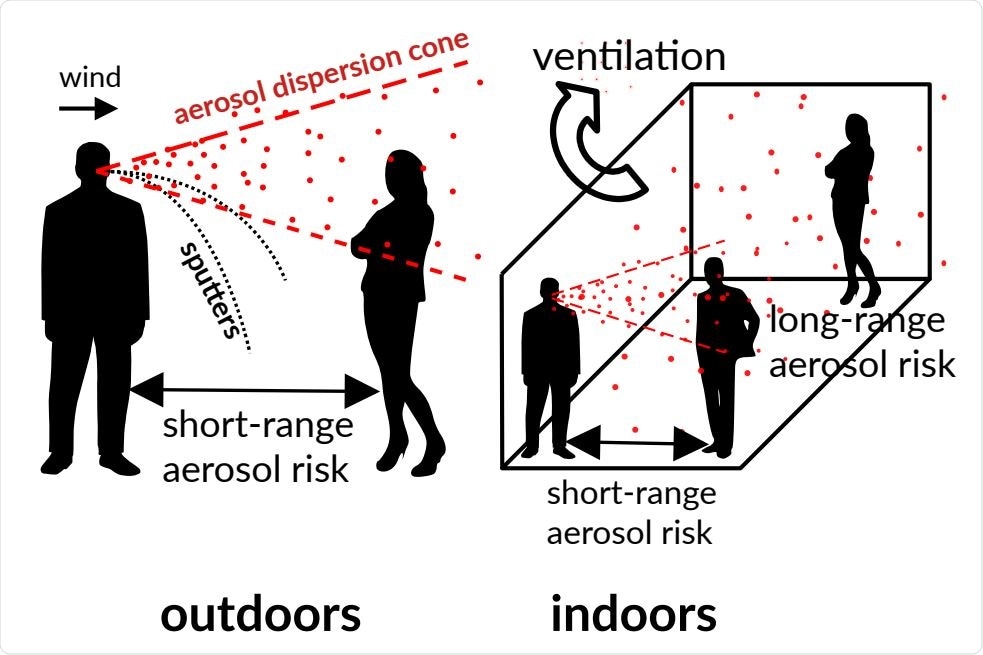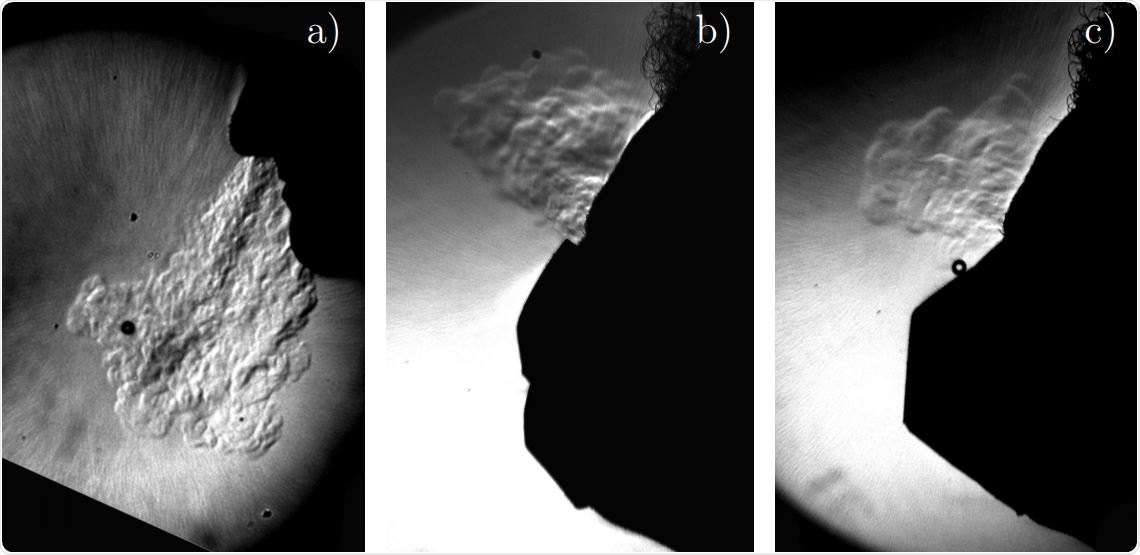The COVID-19 pandemic, caused by severe acute respiratory syndrome coronavirus 2 (SARS-CoV-2), has contributed to significant morbidity, mortality, and economic losses. To date, the virus has infected over 159 million individuals and caused over 3.3 million deaths the world over. The need to mitigate this pandemic has the scientific community revisiting the transmissibility, mechanism, and risk of transmission under certain conditions.
In a recent research study, Florian Poydenot et al. performed a quantitative assessment of indoor and outdoor transmission risk; and how to reduce the contributions of public spaces to the propagation of SARS-CoV-2. The study is published on the medRxiv*, a preprint server for health sciences.
“A quantitative analysis of the viral transmission risk in public spaces allows us to identify the dominant mechanisms that a proactive public health policy can act upon to reduce risk, and to evaluate the reduction of risk that can be obtained.”
The researchers showed that long-range aerosol transmission is controlled by the flow rate of fresh air and by the mask filtering quality, and is quantitatively related to the CO2 concentration, regardless of the room volume and the number of people. Importantly, they found that it is quantitatively related to the CO2 concentration, regardless of the room volume and the number of people.

Long- and short-range airborne transmission of SARS-CoV-2

 This news article was a review of a preliminary scientific report that had not undergone peer-review at the time of publication. Since its initial publication, the scientific report has now been peer reviewed and accepted for publication in a Scientific Journal. Links to the preliminary and peer-reviewed reports are available in the Sources section at the bottom of this article. View Sources
This news article was a review of a preliminary scientific report that had not undergone peer-review at the time of publication. Since its initial publication, the scientific report has now been peer reviewed and accepted for publication in a Scientific Journal. Links to the preliminary and peer-reviewed reports are available in the Sources section at the bottom of this article. View Sources
Using dedicated dispersion experiments performed in two shopping malls, the researchers experimentally investigated the short-range airborne transmission. They found that the exhaled aerosols are dispersed by turbulent draughts in the shape of a cone, leading to a concentration inversely proportional to the squared distance and the flow velocity.
They elaborated on various techniques available to reduce the viral transmission risk in public places. In this study, the researchers showed that the average infection dose, called the viral quantum, can be determined from the epidemiological data (in a manner consistent with experimental biological data).
In the study, the researchers defined and modeled the transmission risk, focusing on the long-range airborne transmission risk (measured using carbon dioxide concentration) and on the short-range airborne transmission risk indoor and outdoor. They examined the quanta generation rate and the dose-response function.

Schlieren imaging of a person exhaling (a) without a mask (b) with a surgical mask (c) with an FFP2 mask. Temperature acts as a passive scalar with respect to turbulent transport, the same way CO2 and small aerosols do. The schlieren technique shows local variations in the air refractive index caused by the warm air exhaled out of the body.
They also looked at the respiratory mask efficiency based on the droplet size distribution, evaporation of liquid droplets (controlled by the ambient relative humidity RH), and the enrichment issue.
It is established that the SARS-CoV-2 is easily spread during expiratory human activities (including breathing, speaking, singing, or laughing), which may cause asymptomatic and pre-symptomatic transmission (as aerosols). Also, indoor transmission is observed to be 19 times more prevalent than outdoors.
Measuring the viral transmission risk in public places (such as schools, offices, university lecture halls, museums, theatres, or shopping centers) and outdoors is a problem. The researchers in this study characterized the dominant transmission routes in social activities and tried to identify efficient ways of reducing the risk of epidemic contamination in public spaces.
In this comprehensive study, the researchers define the risk of transmission in a public space and document its dependence on the number of people present, the average time they are present, the available volume in which aerosols are stored, and the level of ventilation.
They determined the risk assessment for long-range airborne transmission and quantitatively related it to the CO2 concentration.
Interestingly the study showed that short-range airborne transmission, localized in the wake of people infected by SARS-CoV-2, obeys the same physical laws indoors and outdoors.
In the experimental measurements of turbulent dispersion of the passive tracer (CO2) performed in the shopping centers, they found that the turbulent diffusion is due to a small permanent airflow leading to a rapid spatial decay of the tracer concentration. They report that the additional risk when staying in the wake from other people is determined quantitatively as a function of the distance downwind.
In conclusion, the researchers provide a practical definition of the risk r (defined as the average secondary infections per initially infected person) associated with public space. It is related to the integrated quantum emission, to the mask filtration factor (λ), and to the CO2 concentration, which quantifies the dilution factor between exhaled and inhaled air.
Based on this risk assessment, the researchers defined quantitative standards (occupation capacity, CO2 level, ventilation, masks) to be implemented in public spaces to reach the acceptable residual risk.
The goal in the efforts to mitigate COVID-19 is to reduce the pandemic to a level where the overall reproduction rate of the virus is below one. This study provides valuable quantitative guidance for making rational public health policy decisions to prevent the dominant routes of viral transmission through reinforced ventilation, air purification, mechanical dispersion using fans, and incentivizing the wearing of correctly fitted, quality facial masks (surgical masks, possibly covered by another fabric mask, or non-medical FFP2 masks).
These measures taken together significantly reduce the airborne transmission risk of SARS-CoV-2.

 This news article was a review of a preliminary scientific report that had not undergone peer-review at the time of publication. Since its initial publication, the scientific report has now been peer reviewed and accepted for publication in a Scientific Journal. Links to the preliminary and peer-reviewed reports are available in the Sources section at the bottom of this article. View Sources
This news article was a review of a preliminary scientific report that had not undergone peer-review at the time of publication. Since its initial publication, the scientific report has now been peer reviewed and accepted for publication in a Scientific Journal. Links to the preliminary and peer-reviewed reports are available in the Sources section at the bottom of this article. View Sources
Journal references:
- Preliminary scientific report.
Risk assessment for long and short-range airborne transmission of SARS-CoV-2, indoors and outdoors, using carbon dioxide measurements, Florian Poydenot, Ismael Abdourahamane, Elsa Caplain, Samuel Der, Jacques Haiech, Antoine Jallon, Inés Khoutami, Amir Loucif, Emil Marinov, Bruno Andreotti, medRxiv 2021.05.04.21256352; doi: https://doi.org/10.1101/2021.05.04.21256352, https://www.medrxiv.org/content/10.1101/2021.05.04.21256352v1
- Peer reviewed and published scientific report.
Poydenot, Florian, Ismael Abdourahamane, Elsa Caplain, Samuel Der, Jacques Haiech, Antoine Jallon, Inés Khoutami, Amir Loucif, Emil Marinov, and Bruno Andreotti. 2022. “Risk Assessment for Long and Short Range Airborne Transmission of SARS-CoV-2, Indoors and Outdoors.” PNAS Nexus, October. https://doi.org/10.1093/pnasnexus/pgac223. https://academic.oup.com/pnasnexus/article/1/5/pgac223/6750016.
Article Revisions
- Apr 8 2023 - The preprint preliminary research paper that this article was based upon was accepted for publication in a peer-reviewed Scientific Journal. This article was edited accordingly to include a link to the final peer-reviewed paper, now shown in the sources section.